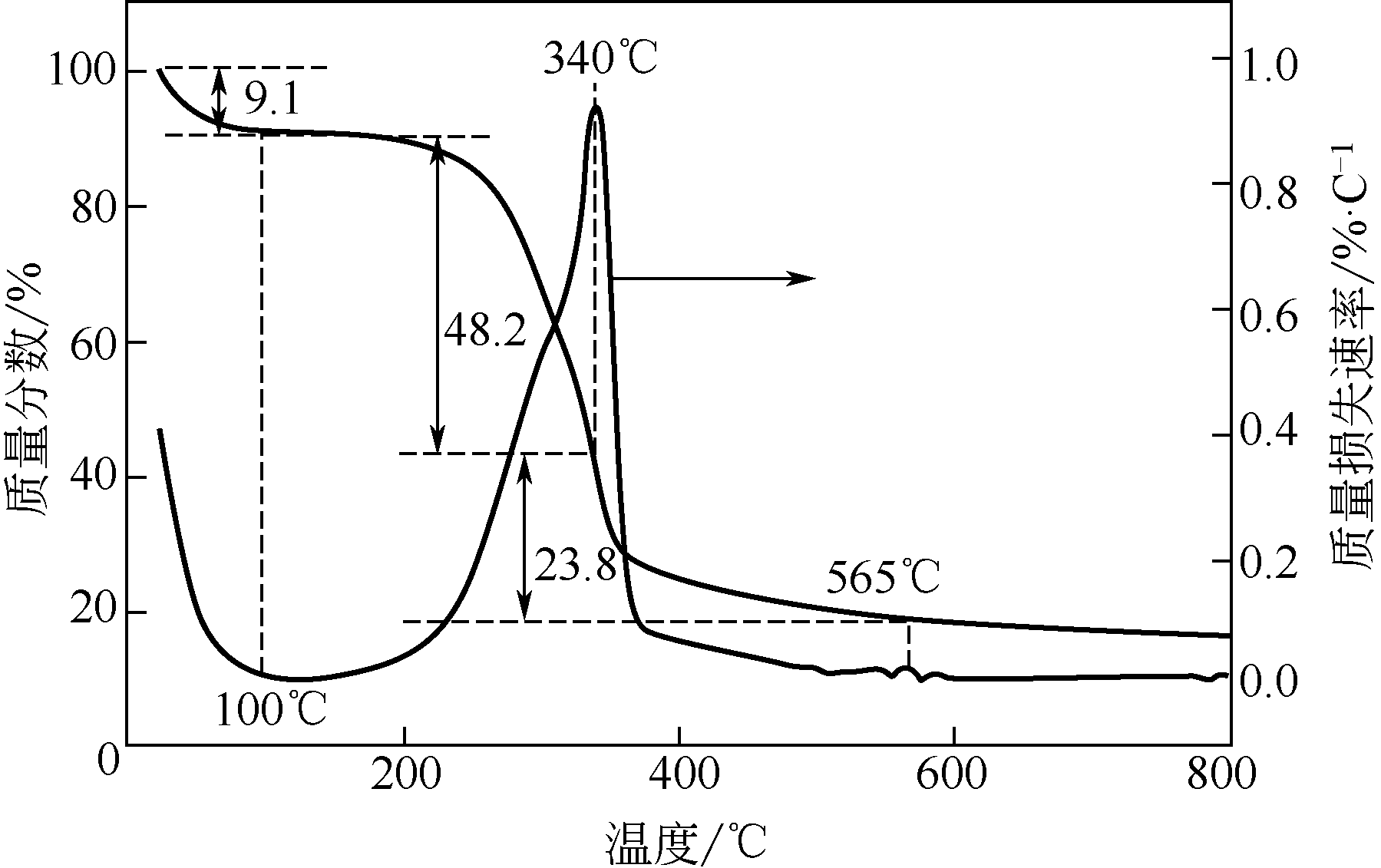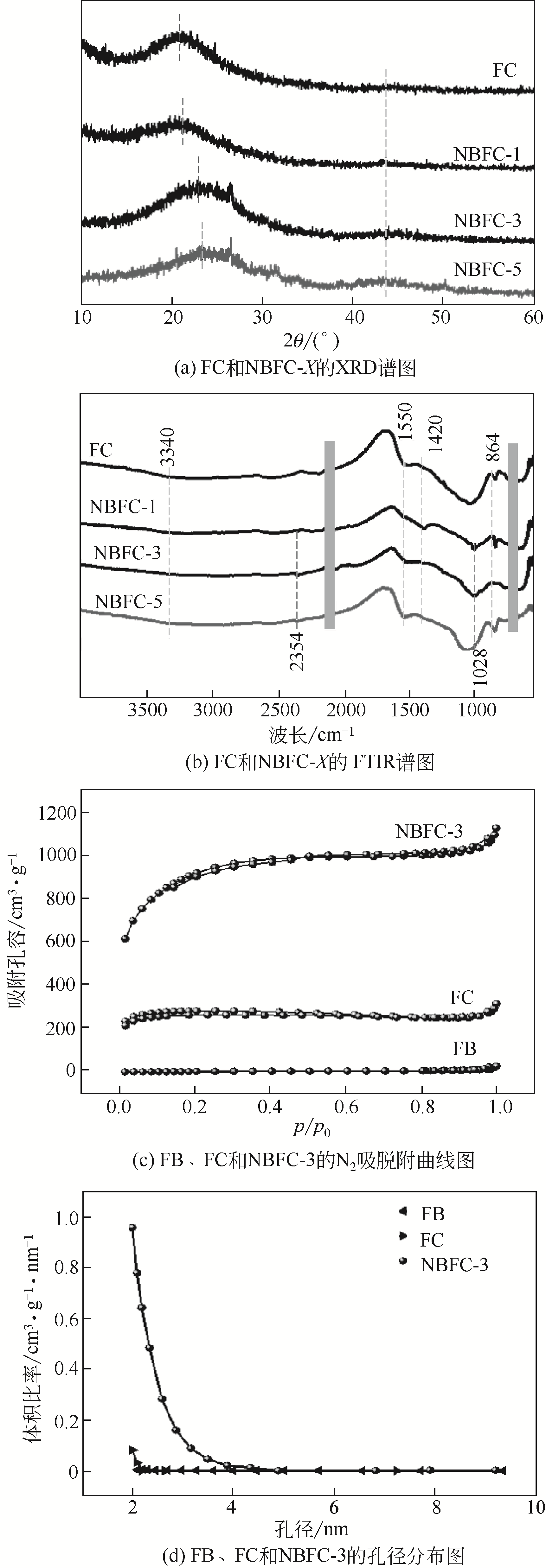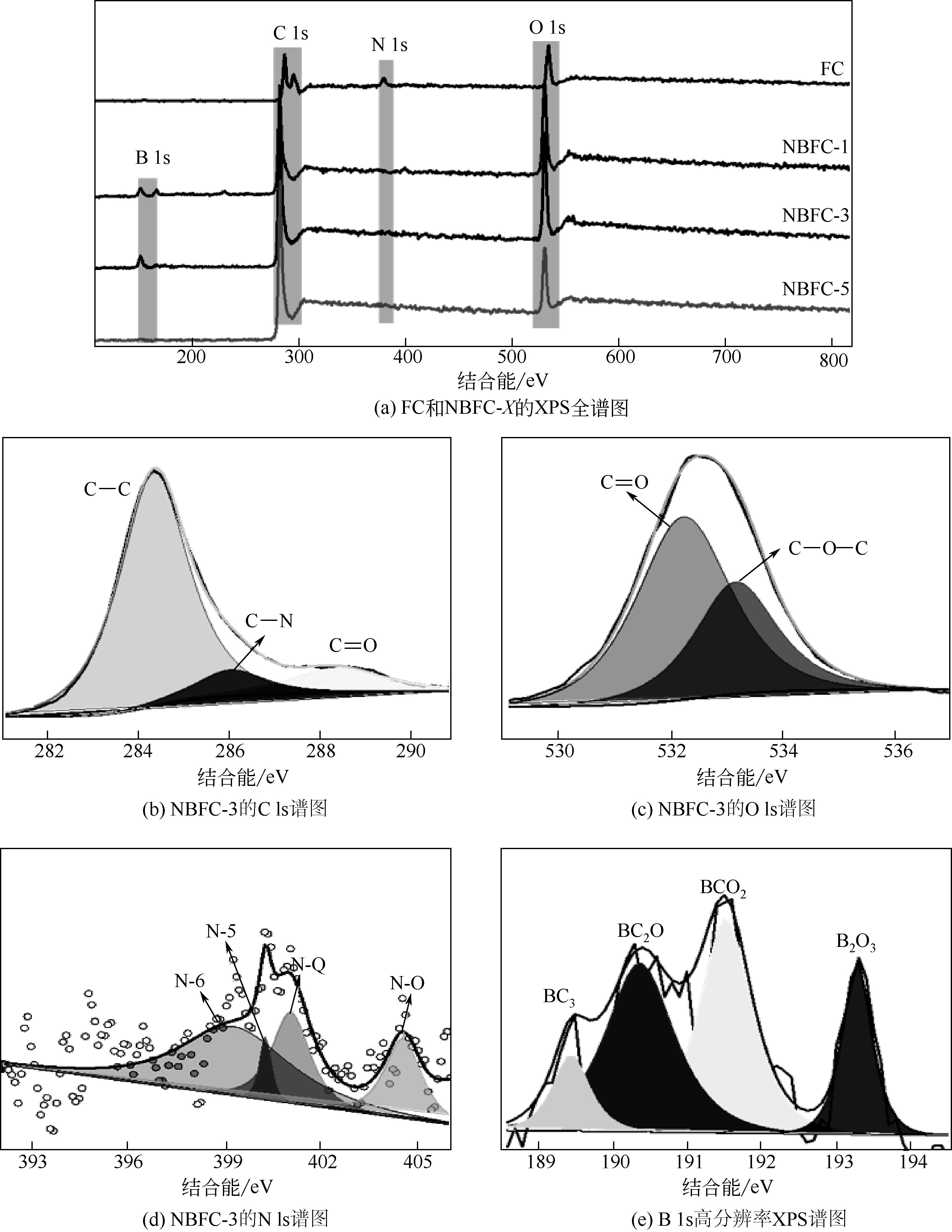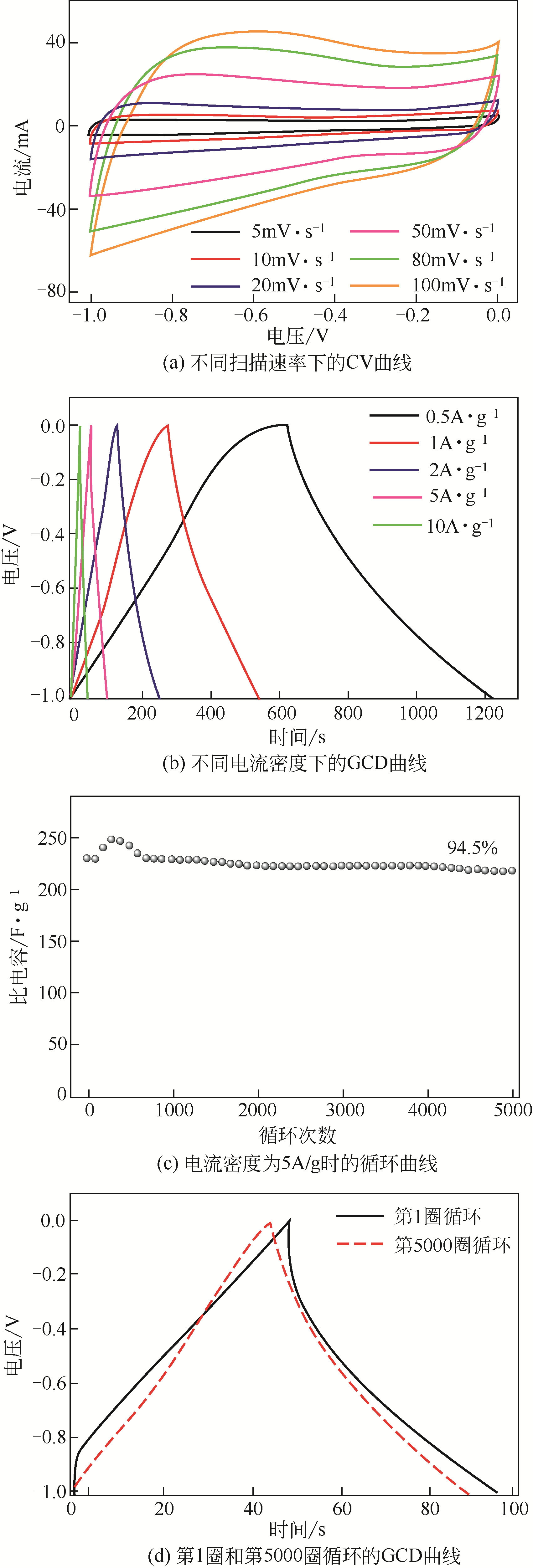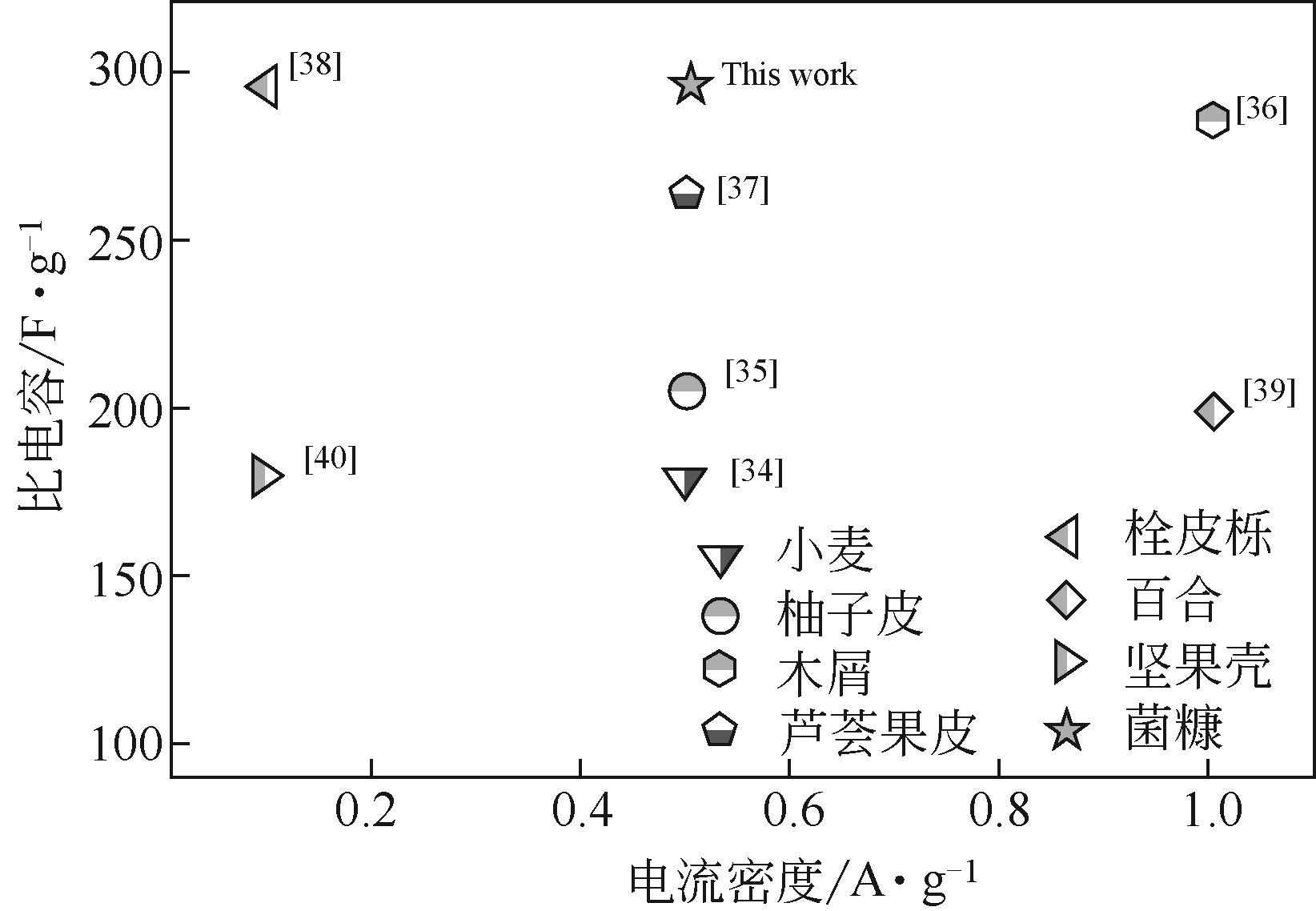化工进展 ›› 2021, Vol. 40 ›› Issue (3): 1527-1536.DOI: 10.16085/j.issn.1000-6613.2020-0804
氮硼掺杂菌糠炭:蜂窝结构用于电极材料
- 东北林业大学材料科学与工程学院,生物质材料科学与技术教育部重点实验室,黑龙江 哈尔滨 150040
-
收稿日期:2020-05-12出版日期:2021-03-05发布日期:2021-03-17 -
通讯作者:黄占华 -
作者简介:曲可琪(1997—),女,博士研究生,研究方向为生物质炭材料的应用。E-mail:qukeqi1997@163.com 。 -
基金资助:国家自然科学基金(31670592);黑龙江省杰出青年基金(JQ2019C001);中央高校基本科研项目(2572020DX01)
N, B-doped carbon from fungus bran: honeycomb structure as electrode material
QU Keqi( ), YOU Yue, SUN Zhe, HUANG Zhanhua(
), YOU Yue, SUN Zhe, HUANG Zhanhua( )
)
- College of Material Science and Engineering, Key Laboratory of Bio-based Material Science and Technology, Ministry of Education, Northeast Forestry University, Harbin 150040, Heilongjiang, China
-
Received:2020-05-12Online:2021-03-05Published:2021-03-17 -
Contact:HUANG Zhanhua
摘要:
绿色可再生、储量丰富且成本低廉的农林废弃物在能源转化利用领域具有重要位置。本文利用中国北方最常见的农林废弃物菌糠为原料,分别以氢氧化钾、硼酸铵为活化剂和掺杂剂,通过简单的高温煅烧法制备了具有蜂窝结构的氮硼双掺杂菌糠炭(NBFC)。NBFC的微观形貌和物理结构表征结果显示:NBFC-3为表面粗糙的蜂窝状多孔材料,孔径集中在2nm左右,比表面积高达2968.48m2/g,具有相互连接的微介孔网络结构。电化学性能测试结果表明:当电流密度为0.5A/g时,NBFC-3的比电容高达297.2F/g。即使当电流密度增加到10A/g后,比电容仍可达218.5F/g,在循环5000圈后(电流密度为5A/g),比电容保持率为94.5%,展现了良好的倍率性能和显著的电化学稳定性。综上,NBFC是一种极有潜力的电化学储能材料。该研究也为农林废弃物菌糠的高效利用提供了新思路。
中图分类号:
引用本文
曲可琪, 尤月, 孙哲, 黄占华. 氮硼掺杂菌糠炭:蜂窝结构用于电极材料[J]. 化工进展, 2021, 40(3): 1527-1536.
QU Keqi, YOU Yue, SUN Zhe, HUANG Zhanhua. N, B-doped carbon from fungus bran: honeycomb structure as electrode material[J]. Chemical Industry and Engineering Progress, 2021, 40(3): 1527-1536.
| 样品 | SBET①/m2·g-1 | V1②/cm3·?g-1 | V2③/cm3·g-1 |
|---|---|---|---|
| FB | 10.41 | 0.001 | 0.02 |
| FC | 849.16 | 0.38 | 0.42 |
| NBFC-3 | 2968.48 | 0.55 | 1.64 |
表1 FB、FC和NBFC-3的比表面积和孔容
| 样品 | SBET①/m2·g-1 | V1②/cm3·?g-1 | V2③/cm3·g-1 |
|---|---|---|---|
| FB | 10.41 | 0.001 | 0.02 |
| FC | 849.16 | 0.38 | 0.42 |
| NBFC-3 | 2968.48 | 0.55 | 1.64 |
| 样品 | C | O | N | B |
|---|---|---|---|---|
| FB | 71.46 | 24.68 | 3.86 | 0 |
| FC | 73.58 | 24.21 | 2.21 | 0 |
| NBFC-3 | 77.90 | 17.30 | 1.46 | 3.34 |
表2 FB、FC和NBFC-3的元素组成(质量分数) (%)
| 样品 | C | O | N | B |
|---|---|---|---|---|
| FB | 71.46 | 24.68 | 3.86 | 0 |
| FC | 73.58 | 24.21 | 2.21 | 0 |
| NBFC-3 | 77.90 | 17.30 | 1.46 | 3.34 |
| 1 | LIANG C, WANG Z. Eggplant-derived SiC aerogels with high-performance electromagnetic wave absorption and thermal insulation properties[J]. Chemical Engineering Journal, 2019, 373: 598-605. |
| 2 | 王欢, 杨东杰, 钱勇, 等. 木质素基功能材料的制备与应用研究进展[J]. 化工进展, 2019, 38(1): 434-448. |
| WANG Huan, YANG Dongjie, QIAN Yong, et al. Recent progress in the preparation and application of lignin-based functional materials[J]. Chemical Industry and Engineering Progress, 2019, 38(1): 434-448. | |
| 3 | FU G, LI Q, YE J, et al. Hierarchical porous carbon with high nitrogen content derived from plant waste (pomelo peel) for supercapacitor[J]. Journal of Materials Science: Materials in Electronics, 2018, 29(9): 7707-7717. |
| 4 | 韩尊强, 邢健雄, 余晓娟, 等. 竹炭及其复合材料在超级电容器中的应用研究进展[J]. 林产化学与工业, 2020, 40(1): 8-16. |
| HAN Zunqiang, XING Jianxiong, YU Xiaojuan, et al. Research progress on bamboo-based supercapacitor electrode material[J]. Chemistry and Industry of Forest Products, 2020, 40(1): 8-16. | |
| 5 | WANG J, ZHANG P, LIU L, et al. Controllable synthesis of bifunctional porous carbon for efficient gas-mixture separation and high-performance supercapacitor[J]. Chemical Engineering Journal, 2018, 348: 57-66. |
| 6 | GUO D, XIN R, WANG Y, et al. N-doped carbons with hierarchically micro- and mesoporous structure derived from sawdust for high performance supercapacitors[J]. Microporous and Mesoporous Materials, 2019, 279: 323-333. |
| 7 | YAGLIKCI S, GOKCE Y, YAGMUR E, et al. The performance of sulphur doped activated carbon supercapacitors prepared from waste tea[J]. Environmental Technology, 2020, 41(1): 36-48. |
| 8 | 李诗杰, 郭常敏, 陈学聪, 等. 基于“蛋盒”结构高电化学性能活性炭的制备[J]. 化工进展, 2020, 39(7): 2698-2705. |
| LI Shijie, GUO Changmin, CHEN Xuecong, et al. Preparation of high performance activated carbon based on “egg-box” structure[J]. Chemical Industry and Engineering Progress, 2020, 39(7): 2698-2705. | |
| 9 | ZHAO C, HUANG Y, ZHAO C, et al. Rose-derived 3D carbon nanosheets for high cyclability and extended voltage supercapacitors[J]. Electrochimica Acta, 2018, 291: 287-296. |
| 10 | WANG Y, YANG B, ZHANG D, et al. Strong polar nonaqueous solvent-assisted microwave fabrication of N and P co-doped microporous carbon for high-performance supercapacitor[J]. Applied Surface Science, 2020, 512: 145711-145720. |
| 11 | LOU Z, SUN Y, BIAN S, et al. Nutrient conservation during spent mushroom compost application using spent mushroom substrate derived biochar[J]. Chemosphere, 2017, 169: 23-31. |
| 12 | 张海波, 闫洋洋, 程红艳, 等. 平菇菌糠生物炭对水体中Pb2+的吸附特性与机制[J]. 环境工程学报, 2020, 14(11): 3170-3181. |
| ZHANG Haibo, YAN Yangyang, CHENG Hongyan, et al. Adsorption characteristics and mechanisms of Pb2+ in water on biochar derived from spent Pleurotus ostreatus substrate[J]. Chinese Journal of Environmental Engineering, 2020, 14(11): 3170-3181. | |
| 13 | WAN L, WEI W, XIE M, et al. Nitrogen, sulfur co-doped hierarchically porous carbon from rape pollen as high-performance supercapacitor electrode[J]. Electrochimica Acta, 2019, 311: 72-82. |
| 14 | LU C, CHEN X. Porous g-C3N4 covered MOF-derived nanocarbon materials for high-performance supercapacitors[J]. RSC Advances, 2019, 9(67): 39076-39081. |
| 15 | GUO D, DING B, HU X, et al. Synthesis of boron and nitrogen codoped porous carbon foam for high performance supercapacitors[J]. ACS Sustainable Chemistry & Engineering, 2018, 6: 11441-11449. |
| 16 | SONG M, ZHOU Y, REN X, et al. Biowaste-based porous carbon for supercapacitor: the influence of preparation processes on structure and performance[J]. Journal of Colloid and Interface Science, 2019, 535: 276-286. |
| 17 | WANG Y, LIU R, TIAN Y, et al. Heteroatoms-doped hierarchical porous carbon derived from chitin for flexible all-solid-state symmetric supercapacitors[J]. Chemical Engineering Journal, 2020, 384: 123263-123272. |
| 18 | ZHANG W, CHEN Z, GUO X, et al. N/S co-doped three-dimensional graphene hydrogel for high performance supercapacitor[J]. Electrochimica Acta, 2018, 278: 51-60. |
| 19 | 曲可琪, 尤月, 程扬, 等. 香菇碳量子点的制备及其对Fe3+的响应[J]. 功能材料, 2019, 50(9): 9215-9220. |
| QU Keqi, YOU Yue, CHENG Yang, et al. Preparation of carbon quantum dots derived from mushroom and their response to Fe3+[J]. Journal of Functional Materials, 2019, 50(9): 9215-9220. | |
| 20 | CHI V, LEE S, CHUNG Y, et al. Synergistic effect of metal-organic framework-derived boron and nitrogen heteroatom-doped three-dimensional porous carbons for precious-metal-free catalytic reduction of nitroarenes[J]. Applied Catalysis B: Environmental, 2019, 257: 117888-117897. |
| 21 | HUANG W, ZHANG A, LIANG H, et al. Novel fabrication of hollow and spinous NiCo2S4 nanotubes templated by natural silk for all-solid-state asymmetric supercapacitors[J]. Journal of Colloid and Interface Science, 2019, 549: 140-149. |
| 22 | SHI C, QI H, MA R, et al. N, S-self-doped carbon quantum dots from fungus fibers for sensing tetracyclines and for bioimaging cancer cells[J]. Materials Science & Engineering C, 2019, 105: 110132-110139. |
| 23 | WANG M, YANG Z, LI W, et al. Superior sodium storage in 3D interconnected nitrogen and oxygen dual-doped carbon network[J]. Small, 2016, 12(19): 2559-2566. |
| 24 | XIA Q, YANG H, WANG M, et al. High energy and high power lithium-ion capacitors based on boron and nitrogen dual-doped 3D carbon nanofibers as both cathode and anode[J]. Advanced Energy Materials, 2017, 7(22): 1701336-1701344. |
| 25 | MAO N, WANG H, SUI Y, et al. Extremely high-rate aqueous supercapacitor fabricated using doped carbon nanoflakes with large surface area and mesopores at near-commercial mass loading[J]. Nano Research, 2017, 10(5): 1767-1783. |
| 26 | FAN B, YAN J, HU A, et al. High-performance potassium ion capacitors enabled by hierarchical porous, large interlayer spacing, active site rich-nitrogen, sulfur co-doped carbon[J]. Carbon, 2020, 164: 1-11. |
| 27 | CHEN H, XIONG Y, YU T, et al. Boron and nitrogen co-doped porous carbon with a high concentration of boron and its superior capacitive behavior[J]. Carbon, 2017, 113: 266-273. |
| 28 | LIN Z, XIANG X, PENG S, et al. Facile synthesis of chitosan-based carbon with rich porous structure for supercapacitor with enhanced electrochemical performance[J]. Journal of Electroanalytical Chemistry, 2018, 823: 563-572. |
| 29 | TANG D, LUO Y, LEI W, et al. Hierarchical porous carbon materials derived from waste lentinus edodes by a hybrid hydrothermal and molten salt process for supercapacitor applications[J]. Applied Surface Science, 2018, 462: 862-871. |
| 30 | MOHAMED S, HUSSAIN I, SHIM J. One-step synthesis of hollow C-NiCo2S4 nanostructures for high-performance supercapacitor electrodes[J]. Nanoscale, 2018, 10: 6620-6628. |
| 31 | LIU Y, LI Z, YAO L, et al. Confined growth of NiCo2S4 nanosheets on carbon flakes derived from eggplant with enhanced performance for asymmetric supercapacitors[J]. Chemical Engineering Journal, 2019, 366: 550-559. |
| 32 | LI B, CHENG Y, DONG L, et al. Nitrogen doped and hierarchically porous carbons derived from chitosan hydrogel via rapid microwave carbonization for high-performance supercapacitors[J]. Carbon, 2017, 122: 592-603. |
| 33 | QU S, CHEN Z, ZHUO H, et al. Using FeCl3 as a solvent, template, and activator to prepare B, N co-doping porous carbon with excellent supercapacitance[J]. ACS Sustainable Chemistry & Engineering, 2019, 7(19): 15983-15994. |
| 34 | LIN G, MA R, ZHOU Y, et al. Three-dimensional interconnected nitrogen-doped mesoporous carbons as active electrode materials for application in electrocatalytic oxygen reduction and supercapacitors[J]. Journal of Colloid and Interface Science, 2018, 527: 230-240. |
| 35 | 史长亮, 邢宝林, 曾会会, 等. 梯级孔生物质活性炭的制备及其电容特性研究[J]. 材料导报, 2018, 32(19): 3318-3324, 3331. |
| SHI Changliang, XING Baolin, ZENG Huihui, et al. Preparation of hierarchical pore biomass activated carbons and their capacitance characteristics[J]. Materials Review, 2018, 32(19): 3318-3324, 3331. | |
| 36 | YANG L, QIU J, WANG Y, et al. Molten salt synthesis of hierarchical porous carbon from wood sawdust for supercapacitors[J]. Journal of Electroanalytical Chemistry, 2020, 856: 113673-113679. |
| 37 | WANG Z, YUN S, WANG X, et al. Aloe peel-derived honeycomb-like bio-based carbon with controllable morphology and its superior electrochemical properties for new energy devices[J]. Ceramics International, 2019, 45(4): 4208-4218. |
| 38 | 许伟佳, 邱大平, 刘诗强, 等. 用于高性能超级电容器电极的栓皮栎基多孔活性炭的制备[J]. 无机材料学报, 2019, 34(6): 625-632. |
| XU Weijia, QIU Daping, LIU Shiqiang, et al. Preparation of cork-derived porous activated carbon for high performance supercapacitors[J]. Journal of Inorganic Materials, 2019, 34(6): 625-632. | |
| 39 | 李志敏, 王倩, 王成娟, 等. 百合生物质碳材料的制备及其电化学性能研究[J]. 西北师范大学学报(自然科学版), 2018, 54(6): 52-57, 63. |
| LI Zhimin, WANG Qian, WANG Chengjuan, et al. Preparation and electrochemical performance of lily bulbs-based porous carbon[J]. Journal of Northwest Normal University (Natural Science), 2018, 54(6): 52-57, 63. | |
| 40 | BOUJIBAR O, GHOSH A, ACHAK O, et al. A high energy storage supercapacitor based on nanoporous activated carbon electrode made from argan shells with excellent ion transport in aqueous and non-aqueous electrolytes[J]. Journal of Energy Storage, 2019, 26: 100958-100965. |
| 41 | ZOU X, WU D, MU Y, et al. Boron and nitrogen co-doped holey graphene aerogels with rich B—N motifs for flexible supercapacitors[J]. Carbon, 2020, 159: 94-101. |
| [1] | 张明焱, 刘燕, 张雪婷, 刘亚科, 李从举, 张秀玲. 非贵金属双功能催化剂在锌空气电池研究进展[J]. 化工进展, 2023, 42(S1): 276-286. |
| [2] | 胡喜, 王明珊, 李恩智, 黄思鸣, 陈俊臣, 郭秉淑, 于博, 马志远, 李星. 二硫化钨复合材料制备与储钠性能研究进展[J]. 化工进展, 2023, 42(S1): 344-355. |
| [3] | 张杰, 白忠波, 冯宝鑫, 彭肖林, 任伟伟, 张菁丽, 刘二勇. PEG及其复合添加剂对电解铜箔后处理的影响[J]. 化工进展, 2023, 42(S1): 374-381. |
| [4] | 雷伟, 姜维佳, 王玉高, 和明豪, 申峻. N、S共掺杂煤基碳量子点的电化学氧化法制备及用于Fe3+检测[J]. 化工进展, 2023, 42(9): 4799-4807. |
| [5] | 王耀刚, 韩子姗, 高嘉辰, 王新宇, 李思琪, 杨全红, 翁哲. 铜基催化剂电还原二氧化碳选择性的调控策略[J]. 化工进展, 2023, 42(8): 4043-4057. |
| [6] | 刘毅, 房强, 钟达忠, 赵强, 李晋平. Ag/Cu耦合催化剂的Cu晶面调控用于电催化二氧化碳还原[J]. 化工进展, 2023, 42(8): 4136-4142. |
| [7] | 张亚娟, 徐惠, 胡贝, 史星伟. 化学镀法制备NiCoP/rGO/NF高效电解水析氢催化剂[J]. 化工进展, 2023, 42(8): 4275-4282. |
| [8] | 王帅晴, 杨思文, 李娜, 孙占英, 安浩然. 元素掺杂生物质炭材料在电化学储能中的研究进展[J]. 化工进展, 2023, 42(8): 4296-4306. |
| [9] | 李海东, 杨远坤, 郭姝姝, 汪本金, 岳婷婷, 傅开彬, 王哲, 何守琴, 姚俊, 谌书. 炭化与焙烧温度对植物基铁碳微电解材料去除As(Ⅲ)性能的影响[J]. 化工进展, 2023, 42(7): 3652-3663. |
| [10] | 徐伟, 李凯军, 宋林烨, 张兴惠, 姚舜华. 光催化及其协同电化学降解VOCs的研究进展[J]. 化工进展, 2023, 42(7): 3520-3531. |
| [11] | 吴锋振, 刘志炜, 谢文杰, 游雅婷, 赖柔琼, 陈燕丹, 林冠烽, 卢贝丽. 生物质基铁/氮共掺杂多孔炭的制备及其活化过一硫酸盐催化降解罗丹明B[J]. 化工进展, 2023, 42(6): 3292-3301. |
| [12] | 张鹏, 潘原. 单原子催化剂在电催化氧还原直接合成过氧化氢中的研究进展[J]. 化工进展, 2023, 42(6): 2944-2953. |
| [13] | 陈少华, 王义华, 胡强飞, 胡坤, 陈立爱, 李洁. 电化学修饰电极在检测Cr(Ⅵ)中的研究进展[J]. 化工进展, 2023, 42(5): 2429-2438. |
| [14] | 李华华, 李逸航, 金北辰, 李隆昕, 成少安. 厌氧氨氧化-生物电化学耦合废水处理系统的研究进展[J]. 化工进展, 2023, 42(5): 2678-2690. |
| [15] | 郭朋举, 何小波, 银凤翔. 电催化氮还原合成氨MOF基催化剂研究进展[J]. 化工进展, 2023, 42(4): 1797-1810. |
| 阅读次数 | ||||||
|
全文 |
|
|||||
|
摘要 |
|
|||||


